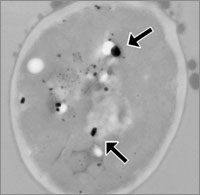Researchers at Harvard's Wyss Institute and Harvard Medical School induce magnetic sensitivity in a non-magnetic organism
BOSTON — Researchers at the Wyss Institute and Harvard Medical School have developed a method for inducing magnetic sensitivity in an organism that is not naturally magnetic — yeast. Their technology could potentially be used to magnetize a variety of different cell types in medical, industrial and research applications. The research findings appear in today’s issue of PLoS Biology.
Magnetic fields are everywhere, but few organisms can sense them. Those that do, such as birds and butterflies, use magnetic sensitivity as a kind of natural global positioning system to guide them along migratory routes. How these few magnetically aware organisms gain their magnetism remains one of biology’s unsolved mysteries.
Researchers Pamela Silver, Ph.D., and Keiji Nishida, Ph.D., were able to imbue yeast with similar properties. Silver, the principal investigator, is a founding core faculty member at the Wyss Institute and a professor of Biochemistry and Systems Biology at Harvard Medical School (HMS). Nishida is a research fellow in Systems Biology at HMS. “Magnetism in nature is a unique and mysterious biological function that very few living systems exploit,” said Silver. “So while magnetic yeast may not sound like a serious scientific breakthrough, it’s actually a highly significant first step toward harnessing this natural phenomenon and applying it to all sorts of important practical purposes.”

The presence of iron can cause magnetism, but most cells, if exposed to this common metal, hide it away in sealed-off cavities where it cannot have an effect. Silver and Nishida were able to block expression of the protein that causes the iron sequestration, allowing the iron to circulate freely throughout the yeast cell. In this way, they created enough magnetic sensitivity in the cell to cause it to migrate toward an external magnet.
The researchers also found a gene that correlates with magnetism by instructing the production of a critical protein that can dial up magnetism. They then enhanced the magnetic sensitivity even further through interaction with a second protein that regulates cell metabolism. Since the same metabolic protein functions similarly in cells ranging from simple yeast to more advanced — even human — cells, the new method could potentially be applied to a much wider range of organisms.
Silver notes that in an industrial setting, magnetization could be extremely helpful as a means of targeting and isolating specific cells. Contaminated cells could be pulled out and disposed of during the processing of biological materials, and cells that are critical to a certain manufacturing process could be isolated and put to use. Magnetic cells could also be used to interact with non-living machinery. For example, magnetism could be used in tissue engineering to guide cells to layer themselves on a scaffold in a specific way. New therapies might one day be created in which cells are engineered to respond to a magnetic field by growing or healing, and implanted magnetic stem cells might one day be tracked with magnetic resonance imaging.
“This work shows how design principles from one type of cell can be harnessed using synthetic biology to transfer novel functionalities to another, which is a core approach driving the field of biologically inspired engineering,” said Wyss Institute Founding Director Donald Ingber, M.D. Ph.D. Ingber is also the Judah Folkman Professor of Vascular Biology at Harvard Medical School and the Vascular Biology Program at Children’s Hospital Boston, and Professor of Bioengineering at Harvard’s School of Engineering and Applied Sciences. “The ability to control cells magnetically will also synergize with many other technologies in the pipeline at the Wyss Institute that rely on use of magnetic fields to control cell functions remotely, or to isolate rare cells from biological fluids.”
Watch the video…
